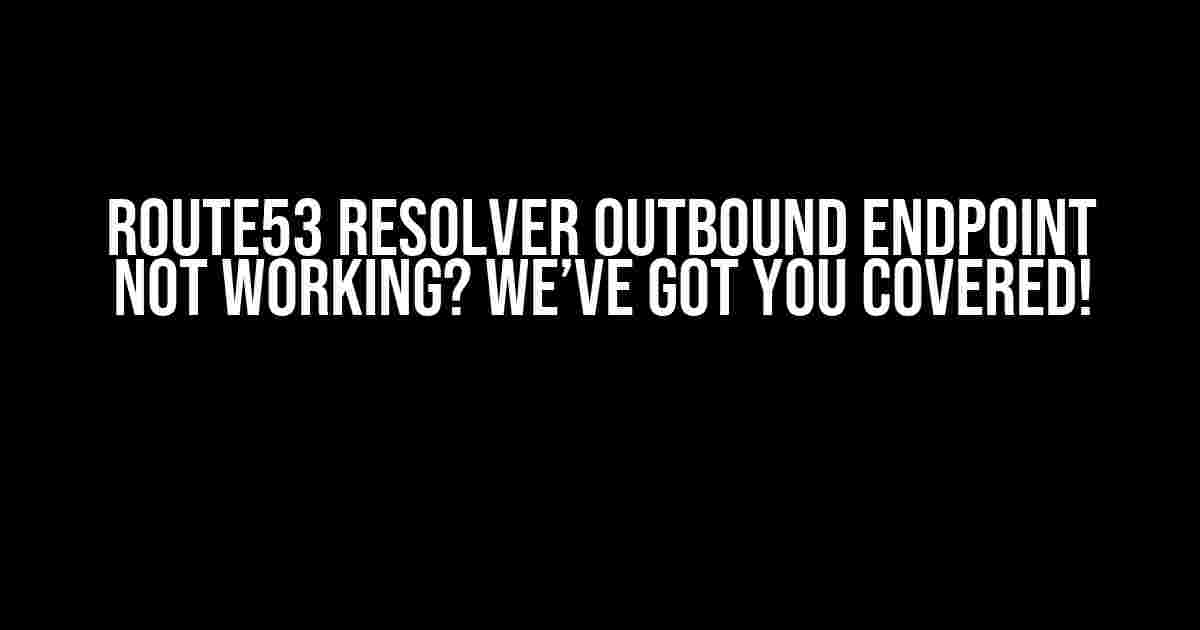If you’re reading this, chances are you’re frustrated with your Route53 Resolver outbound endpoint not working as expected. Don’t worry, we’re here to help you troubleshoot and fix the issue. In this article, we’ll dive deep into the world of Route53 Resolver, explore common pitfalls, and provide step-by-step instructions to get your outbound endpoint up and running smoothly.
What is Route53 Resolver?
Route53 Resolver is a powerful DNS service offered by AWS that enables you to route internet traffic to your application. It’s a critical component of your infrastructure, as it directs users to your website, application, or service. Resolver provides both inbound and outbound endpoints, which we’ll discuss in more detail later.
Understanding Outbound Endpoints
An outbound endpoint is a critical component of Route53 Resolver that allows your application to send DNS queries to the internet. It’s essentially a gateway that enables your application to communicate with external DNS resolvers, such as Google Public DNS or Cloudflare. Without a functioning outbound endpoint, your application won’t be able to resolve external domains, leading to a plethora of issues.
Common Issues with Outbound Endpoints
Before we dive into troubleshooting, let’s cover some common issues that might cause your outbound endpoint to malfunction:
- Incorrect configuration: Misconfigured Route53 Resolver settings can lead to issues with the outbound endpoint.
- Network connectivity problems: Firewalls, security groups, or network ACLs might block traffic between your application and the outbound endpoint.
- Resource limitations: Insufficient resources, such as CPU or memory, can cause the outbound endpoint to fail.
- Network latency: High latency between your application and the outbound endpoint can cause timeouts and errors.
Troubleshooting Your Outbound Endpoint
Now that we’ve covered the basics, let’s get our hands dirty and troubleshoot the issue. Follow these steps to identify and fix the problem:
-
Verify your Route53 Resolver configuration:
aws route53resolver get-resolver --resolver-id your-resolver-id{ "Resolver": { "Id": "your-resolver-id", "Arn": "arn:aws:route53resolver:REGION:ACCOUNT_ID:resolver/your-resolver-id", "Name": "your-resolver-name", "ResolverEndpoint": { "Id": "your-endpoint-id", "IpAddresses": [ "192.0.2.1" ], "Port": 53, "OutboundEndpoints": [ { "IpAddresses": [ "198.51.100.1" ] } ] } } } -
Check your security groups and network ACLs:
aws ec2 describe-security-groups --group-ids your-sg-id{ "SecurityGroups": [ { "OwnerId": "ACCOUNT_ID", "GroupId": "your-sg-id", "GroupName": "your-sg-name", "Description": "Allow outbound traffic to DNS resolvers", "IpPermissions": [ { "IpProtocol": "-1", "FromPort": 53, "ToPort": 53, "IpRanges": [ { "CidrIp": "0.0.0.0/0" } ] } ] } ] } -
Verify resource utilization:
aws cloudwatch get-metric-statistics --namespace AWS/EC2 --metric-name CPUUtilization --start-time 1h ago --end-time now --period 300 --statistics Average --dimensions Name=InstanceId,Value=i-your-instance-id{ "Label": "CPUUtilization", "Datapoints": [ { "Timestamp": "2023-02-20T14:30:00Z", "Average": 30.0, "Unit": "Percent" } ] } -
Check network latency:
ping 198.51.100.1PING 198.51.100.1 (198.51.100.1): 56 data bytes 64 bytes from 198.51.100.1: icmp_seq=0 ttl=55 time=25.3 ms 64 bytes from 198.51.100.1: icmp_seq=1 ttl=55 time=27.1 ms
Common Solutions
Now that you’ve identified the issue, let’s fix it! Here are some common solutions to get your outbound endpoint up and running:
| Issue | Solution |
|---|---|
| Incorrect configuration | Review and update your Route53 Resolver configuration to ensure correct settings. |
| Network connectivity problems | Update your security groups and network ACLs to allow outbound traffic to DNS resolvers. |
| Resource limitations | Scale up your instance or adjust resource allocation to ensure sufficient CPU and memory. |
| Network latency | Optimize your network configuration, consider using a closer DNS resolver, or implement caching. |
Best Practices for Outbound Endpoints
To avoid common pitfalls and ensure your outbound endpoint remains functional, follow these best practices:
- Use a robust and scalable instance type for your Route53 Resolver.
- Implement security groups and network ACLs that allow outbound traffic to DNS resolvers.
- Monitor resource utilization and adjust as needed.
- Optimize your network configuration for low latency and high availability.
- Regularly test your outbound endpoint to identify potential issues.
Conclusion
If you’ve made it this far, congratulations! You’ve successfully troubleshooted and fixed your Route53 Resolver outbound endpoint. Remember to follow best practices, monitor your resources, and test your endpoint regularly to ensure seamless communication with external DNS resolvers. If you’re still experiencing issues, don’t hesitate to reach out to AWS support or a certified AWS engineer for further assistance.
Keep in mind that this article is just a starting point, and you may need to adapt the solutions to your specific use case. With a little patience and persistence, you’ll be well on your way to resolving DNS queries like a pro!
Frequently Asked Question
Stuck with your Route 53 Resolver Outbound Endpoint? Don’t worry, we’ve got you covered! Here are some frequently asked questions to help you troubleshoot the issue.
Why is my Route 53 Resolver Outbound Endpoint not working?
The most common reason is incorrect configuration or permissions issues. Double-check your IAM role, VPC, and subnet settings. Ensure that your IAM role has the necessary permissions to create and manage the outbound endpoint.
What are the common error messages I might see?
You might encounter errors like “Endpoint not found” or “Failed to create endpoint”. Check the AWS CloudTrail logs to identify the specific error message and troubleshoot accordingly.
How do I check the status of my outbound endpoint?
Head to the Route 53 console, navigate to the Resolver section, and check the status of your outbound endpoint. If it’s not working as expected, try updating the endpoint or checking the resolver logs for more information.
Can I use AWS CLI to troubleshoot my outbound endpoint?
Yes! Use the AWS CLI command `aws route53resolver get-resolver-endpoint –resolver-endpoint-id ` to check the status and details of your outbound endpoint. You can also use AWS CLI to update or delete the endpoint if needed.
What if none of the above solutions work?
Don’t worry! Reach out to AWS Support or a certified AWS expert for personalized assistance. They can help you dive deeper into the issue and provide a customized solution.
